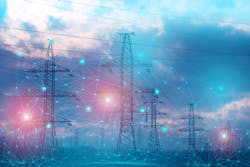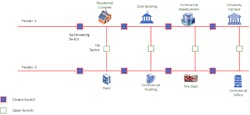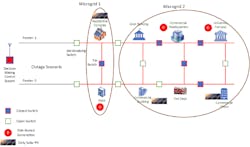How the ‘grid of the future’ starts with sectionalizing the grid today
There’s the electric grid we have today — built to carry electricity one way from large, predictable power plants to homes and businesses. And there’s the smart, decentralized, multidirectional electric grid of the future that many experts say we must transition to in order to achieve clean, reliable, resilient electric service with net-zero carbon emissions.
But that ocean between them might not be as large as many think. In fact, we already have a good sense of how to navigate across it. The technology already exists to do it.
Sectionalizing the grid
A critical step to get to the ideal future state, which some utilities are starting to do today, is sectionalizing the grid. So, what is sectionalizing?
The grid that serves each region is not one large organism that’s either on or off. Look at the grid infrastructure in any average community and you’re likely to find at least two “feeders,” or circuits, that serve electricity to homes and businesses. On these feeders, there are sectionalizing switches that allow for isolating the faults on the wires. There are normally open tie switches that allow grid operators to open or close these passages for electricity and enable transfer of the loads from one distribution circuit to the other distribution circuit.
Most of the time, the tie passages are open and the lights are on. If there’s a power outage, a utility will flip a sectionalizing switch and a tie switch so power to the first feeder can be restored from the second feeder. Once that’s accomplished, the switch is turned back on and power flows back for the “downstream” customers.
That design creates an opportunity for the grid of the future thanks to new digital and autonomous grid technology and the emergence of distributed energy resources (DERs) such as rooftop solar and community microgrids.
Let’s imagine there is a massive outage from a storm and power is likely to be out for days. Those solar rooftops and community microgrids are still generating power. For many hours, they may be generating more power than their owners need.
Using sectionalizing switches located on the grid feeders, utilities can flip switches open and closed to create combinations of hyperlocal microgrids.
In this extended power outage scenario, DERs can be pooled to create a microgrid that helps keep the local hospital online. Or the utility could flip switches every few hours to shift the microgrid from one neighborhood to the next, providing every customer power for at least some time to perform critical tasks.
Sectionalizing the grid can also help avoid large outages to begin with. As Texas’ ERCOT grid experienced famously in February 2021, when a few power plants unexpectedly go down, the whole grid can go out for days. By sectionalizing the grid into partitions that can each be served by different generation resources, the sections can automatically be closed off and served independently by power within their sectionalized grid while waiting for other sources of central generation to come back.
Learn more about sectionalizing the grid during Siemens presentation at Microgrid 2022!
The decisions needed to make all this work must happen too fast to be controlled by human operators, but smart grid control technology exists to make these sectionalizing decisions autonomously and seamlessly.
What are the benefits?
Upgrading the grid at a national scale is no small task, so any major strategy to deploy new technology needs to reap many benefits. At Siemens, we believe sectionalizing the grid does just that through five main benefits:
- Enhanced grid resilience and recovery: As Texas experienced, there can be major repercussions if the grid is not resilient to extreme weather nor designed to recover quickly.
- Improved electric reliability: Reliability is one of the highest goals for utilities and their regulators. Sectionalizing the grid means improved utility reliability metrics and service to communities, specifically through the continued use of solar PV even during blackouts with a reference power source.
- Lowered cost of electricity: For microgrid and DER owners, sectionalizing can create opportunities to provide their energy to the grid as a revenue-generating service. For utilities, they could lower the cost of demand response programs by addressing grid challenges at the most micro level possible, combining sectionalizing with calls for demand response in very specific sections of the grid, instead of wide areas.
- Increased cybersecurity through risk mitigation protocols: When cyberattacks occur on the communication and protocol level on the grid, the whole grid can be impacted. By sectionalizing, sections of the grid can automatically close themselves off from attack and work on their own until security is restored to other portions of the grid. In other words, once a particular closed-off section of the grid is restored, verified and available, the sectionalized network can rejoin the main infrastructure network.
- Upgraded distributed energy management: The same smart grid technology that boosts reliability and resilience during challenging times also serves as a distributed energy resource management system (DERMS). Used as a DERMS, the technology can autonomously make decisions to balance the grid, based on millions of data points from solar systems, microgrids, electric vehicle chargers and more, which give it a clear view into the constant fluctuations of power supply and demand.
When will the future be here?
The grid modernizations needed to achieve this grid future are already happening. In places like California, grid operators essentially have no choice as they take steps to keep the grid working in the face of more DERs.
The effort simply needs to accelerate and be more coordinated. That means utilities need to advocate for authorization to spend money on these critical grid upgrades. State regulators need to approve those requests or ask their utilities to come to them with a plan for action. No one should wait until more extreme weather, electric vehicles and DERs stretch the grid to a breaking point.
Rather than face that nightmare, sectionalizing is the step we can start taking today to ensure the grid of the future helps us achieve the dream of a clean, reliable, resilient electric system.
Rafael Ozaki is business unit CEO at Siemens Grid Software US.



